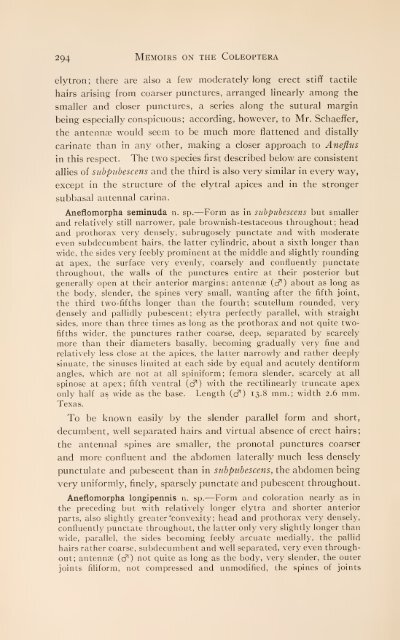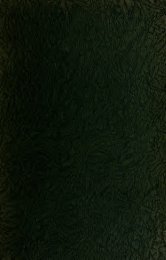Memoirs on the coleoptera
Memoirs on the coleoptera
Memoirs on the coleoptera
You also want an ePaper? Increase the reach of your titles
YUMPU automatically turns print PDFs into web optimized ePapers that Google loves.
294<br />
elytr<strong>on</strong> <strong>the</strong>re ;<br />
MEMOIRS ON THE COLEOPTERA<br />
are also a few moderately l<strong>on</strong>g<br />
erect stiff tactile<br />
hairs arising from coarser punctures, arranged linearly am<strong>on</strong>g <strong>the</strong><br />
smaller and closer punctures, a series al<strong>on</strong>g <strong>the</strong> sutural margin<br />
being especially c<strong>on</strong>spicuous; according, however, to Mr. Schaeffer,<br />
<strong>the</strong> antennae would seem to be much more flattened and distally<br />
carinate than in any o<strong>the</strong>r, making a closer approach to Aneflus<br />
in this respect. The two species first described below are c<strong>on</strong>sistent<br />
allies of subpubescens and <strong>the</strong> third is also very similar in every way,<br />
except in <strong>the</strong> structure of <strong>the</strong> elytral apices and in <strong>the</strong> str<strong>on</strong>ger<br />
subbasal antennal carina.<br />
Aneflomorpha seminuda n. sp. Form as in subpubescens but smaller<br />
and relatively still narrower, pale brownish-testaceous throughout; head<br />
and prothorax very densely, subrugosely punctate and with moderate<br />
even subdecumbent hairs, <strong>the</strong> latter cylindric, about a sixth l<strong>on</strong>ger than<br />
wide, <strong>the</strong> sides very feebly prominent at <strong>the</strong> middle and slightly rounding<br />
at apex, <strong>the</strong> surface very evenly, coarsely and c<strong>on</strong>fluently punctate<br />
throughout, <strong>the</strong> walls of <strong>the</strong> punctures entire at <strong>the</strong>ir posterior but<br />
generally open at <strong>the</strong>ir anterior margins; antennse (cT) about as l<strong>on</strong>g as<br />
<strong>the</strong> body, slender, <strong>the</strong> spines very small, wanting after <strong>the</strong> fifth joint,<br />
<strong>the</strong> third two-fifths l<strong>on</strong>ger than <strong>the</strong> fourth; scutellum rounded, very<br />
densely and pallidly pubescent; elytra perfectly parallel, with straight<br />
sides, more than three times as l<strong>on</strong>g as <strong>the</strong> prothorax and not quite two-<br />
fifths wider, <strong>the</strong> punctures ra<strong>the</strong>r coarse, deep, separated by scarcely<br />
more than <strong>the</strong>ir diameters basally, becoming gradually very fine and<br />
relatively less close at <strong>the</strong> apices, <strong>the</strong> latter narrowly and ra<strong>the</strong>r deeply<br />
sinuate, <strong>the</strong> sinuses limited at each side by equal and acutely dentiform<br />
angles, which are not at all spiniform; femora slender, scarcely<br />
at all<br />
spinose at apex; fifth ventral (a 71<br />
) with <strong>the</strong> rectilinearly truncate apex<br />
<strong>on</strong>ly half as wide as <strong>the</strong> base. Length (c?) 13.8 mm.; width 2.6 mm.<br />
Texas.<br />
To be known easily by <strong>the</strong> slender parallel form and short,<br />
decumbent, well separated hairs and virtual absence of erect hairs;<br />
<strong>the</strong> antennal spines are smaller, <strong>the</strong> pr<strong>on</strong>otal punctures coarser<br />
and more c<strong>on</strong>fluent and <strong>the</strong> abdomen laterally much less densely<br />
punctulate and pubescent than in subpubescens, <strong>the</strong> abdomen being<br />
very uniformly, finely, sparsely punctate and pubescent throughout.<br />
Aneflomorpha l<strong>on</strong>gipennis n. sp. Form and colorati<strong>on</strong> nearly as in<br />
<strong>the</strong> preceding but with relatively l<strong>on</strong>ger elytra and shorter anterior<br />
parts, also slightly greater 'c<strong>on</strong>vexity; head and prothorax very densely,<br />
c<strong>on</strong>fluently punctate throughout, <strong>the</strong> latter <strong>on</strong>ly very slightly l<strong>on</strong>ger than<br />
wide, parallel, <strong>the</strong> sides becoming feebly arcuate medially, <strong>the</strong> pallid<br />
hairs ra<strong>the</strong>r coarse, subdecumbent and well separated, very even throughout;<br />
antennae (cT) not quite as l<strong>on</strong>g as <strong>the</strong> body, very slender, <strong>the</strong> outer<br />
joints filiform, not compressed and unmodified, <strong>the</strong> spines of joints



